Diary of a Root Sprite
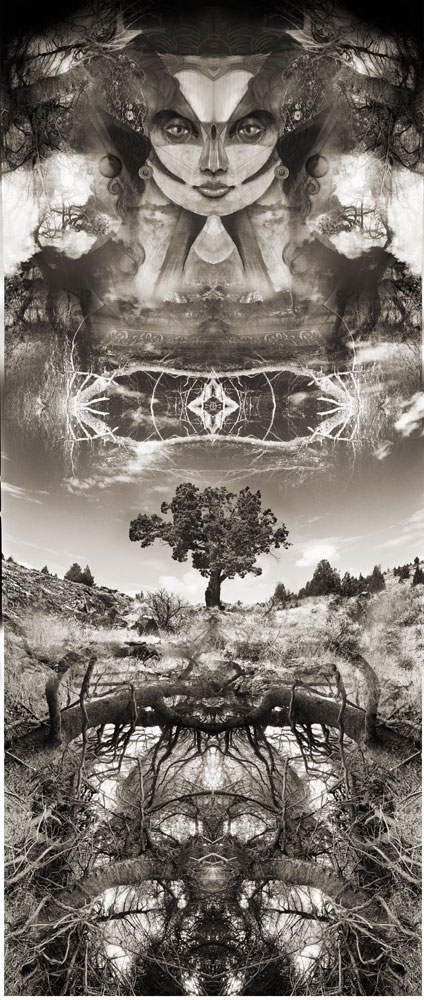
On this page I'm going to show you a step by step view of the layering of this artwork. Skip to the last paragraph if you just want my formal remarks of the thematic content.
We'll start with the first scan of four that made up the underlying 'roots' layer. I've added negative space to the illustrations so that you can see the final bounds of the composition. I took 5 or 6 shots in this location and ended up 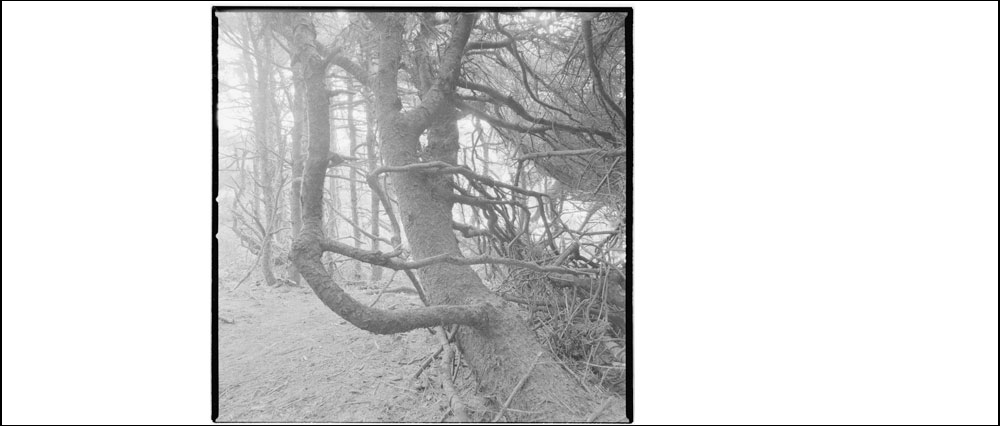 using four. I exposed black and white negative film at a level that would give me details in the darkest shadows, letting the white sky beyond the woods blow out. The image you see here is how the 16bit BW file looked on my computer before doing any levels or curve
using four. I exposed black and white negative film at a level that would give me details in the darkest shadows, letting the white sky beyond the woods blow out. The image you see here is how the 16bit BW file looked on my computer before doing any levels or curve 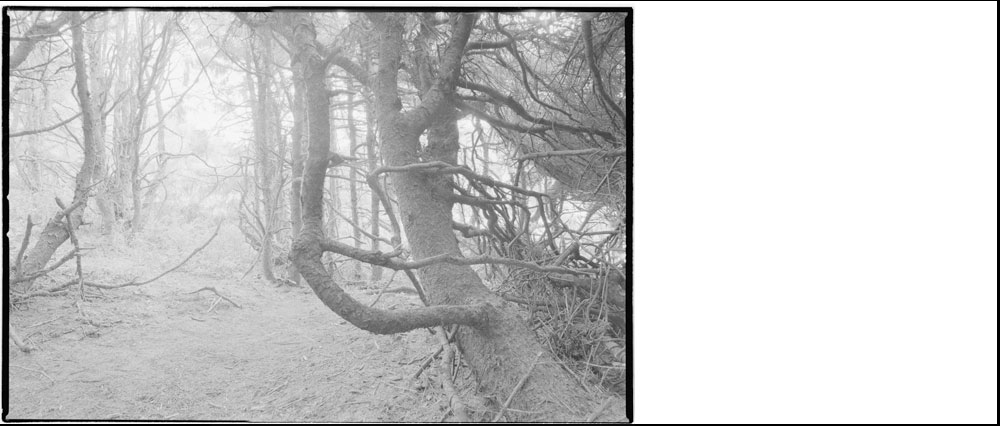 adjustments. I then began to add other shots from the same scene. You can see that I have a liberal overlap between shots. this gives me a lot of flexibility about where to put the transition mask in the composition. It's probably obvious that when you shoot panoramas, you want the
adjustments. I then began to add other shots from the same scene. You can see that I have a liberal overlap between shots. this gives me a lot of flexibility about where to put the transition mask in the composition. It's probably obvious that when you shoot panoramas, you want the 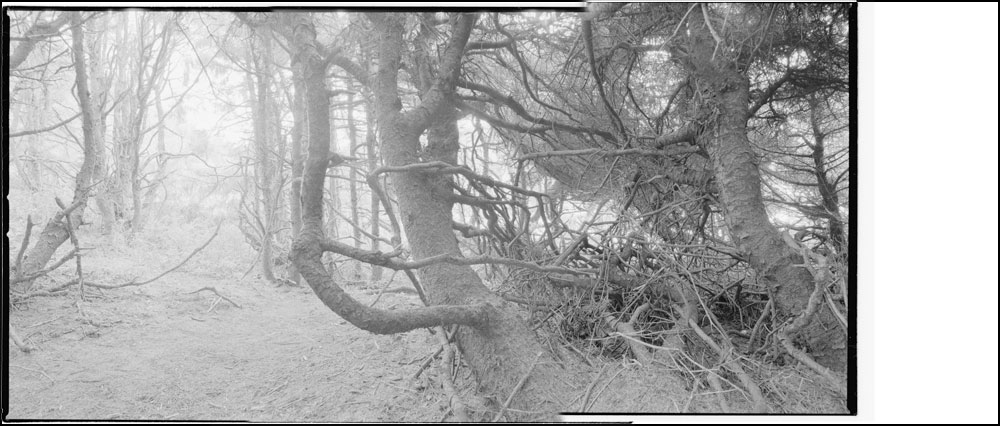 camera to stay on the same horizontal axis as you sweep the scene with your lens. But that can be tricky when there is no horizon like to follow. You can see that These images did not line up quite perfectly and I know I used some scaling and warping adjustments along with delicate
camera to stay on the same horizontal axis as you sweep the scene with your lens. But that can be tricky when there is no horizon like to follow. You can see that These images did not line up quite perfectly and I know I used some scaling and warping adjustments along with delicate 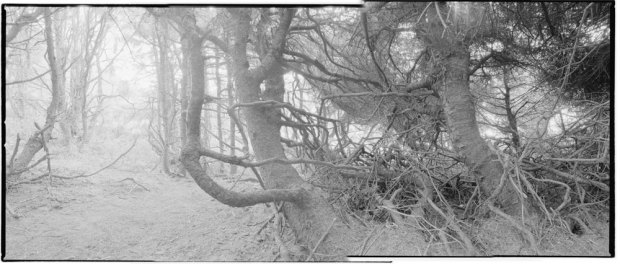 use of the cloning tool to push the image back into the right spot. The truth is that busy subject matter like bushes trees, anything chaotic, are very forgiving to misalignment in the stitching process. I then made a series of curve and levels adjustments, a very careful and delicate process, to bring the tonalities of the print where I wanted them. It usually takes two or three sequential adjustments rather than one big adjustment to get it right.
use of the cloning tool to push the image back into the right spot. The truth is that busy subject matter like bushes trees, anything chaotic, are very forgiving to misalignment in the stitching process. I then made a series of curve and levels adjustments, a very careful and delicate process, to bring the tonalities of the print where I wanted them. It usually takes two or three sequential adjustments rather than one big adjustment to get it right. 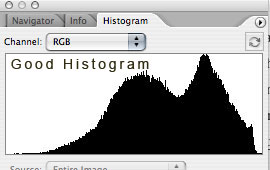 When you work in 16 bit mode you have to believe that the file has tons more data than you can see on the screen, which is probably only 8 bit, and certainly not 16bit. What your trying to do at this point is coax all that detail information back into the range of your monitor and other output media.
When you work in 16 bit mode you have to believe that the file has tons more data than you can see on the screen, which is probably only 8 bit, and certainly not 16bit. What your trying to do at this point is coax all that detail information back into the range of your monitor and other output media.
Use the histogram tool to keep from clipping data at the edges. you always want a gradual fall off at the edges of your histogram like nice rolling hills, rather than a sudden cliff which means you've probably lost a lot of detail in the whites or darks.
you always want a gradual fall off at the edges of your histogram like nice rolling hills, rather than a sudden cliff which means you've probably lost a lot of detail in the whites or darks.
The next thing I did was covert to 16 bit RGB and apply my own flavor of duotone tint (not using the duotone mode). I do this with two self masking hue adjustments one for the darks and one for the highlights.
 Now at this point I have an image that I feel stands alone as a finished work of art in terms of a nice traditional photographic print. A perfectly good reason to keep going! I was curious about symmetries on this so I did a flip on both horizontal and vertical axis. Again I have an intriguing finished piece.
Now at this point I have an image that I feel stands alone as a finished work of art in terms of a nice traditional photographic print. A perfectly good reason to keep going! I was curious about symmetries on this so I did a flip on both horizontal and vertical axis. Again I have an intriguing finished piece. 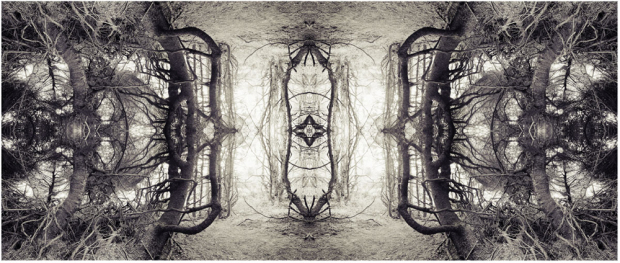 I would love to do a gallery show of just this type of imagery at some point. I'll have to make a symmetry gallery on this site as well. Now the fun starts. I decide to make this the background for a much more elaborate composition. I go back to BW mode and I rotate the image into vertical position. At first because I'm seeing some really cool figurative faces and bodies in the symmetrical branches.
I would love to do a gallery show of just this type of imagery at some point. I'll have to make a symmetry gallery on this site as well. Now the fun starts. I decide to make this the background for a much more elaborate composition. I go back to BW mode and I rotate the image into vertical position. At first because I'm seeing some really cool figurative faces and bodies in the symmetrical branches.
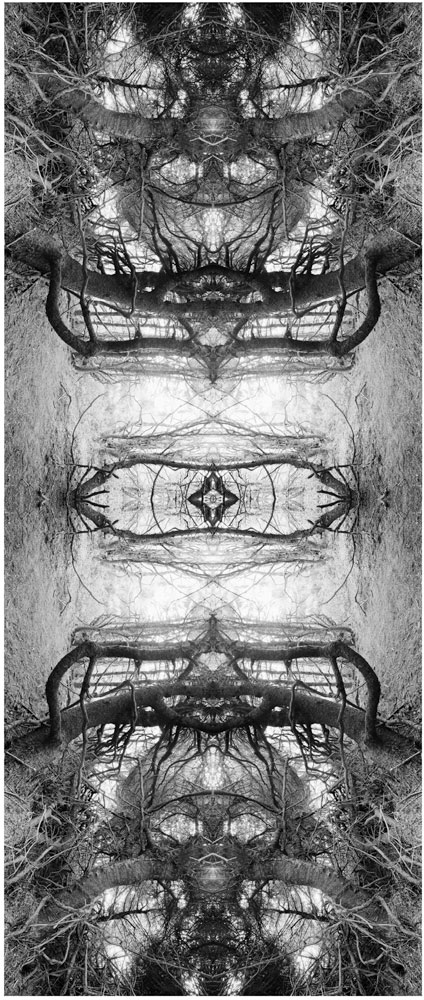
Then I add this tree

which used to look like this
before I cleaned it up to be this 
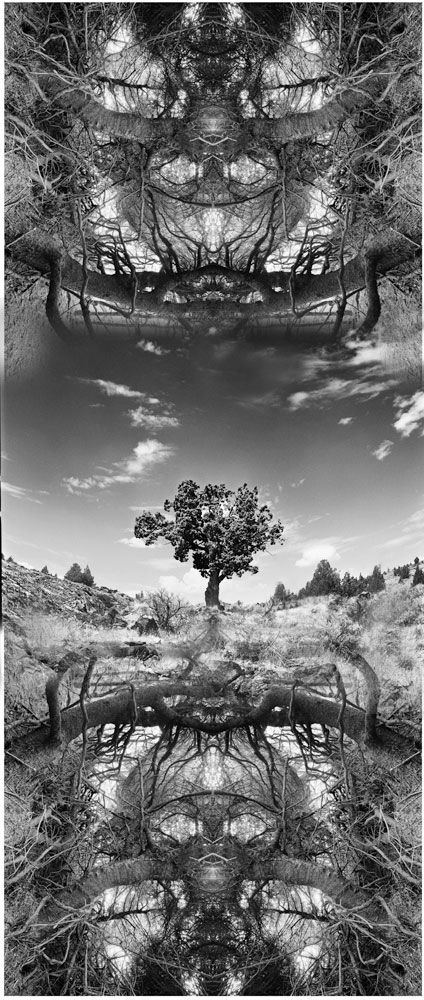
giving me a composition that looks like this
Then I invert a portion of the upper branches/roots preparing for the lighter tones of clouds
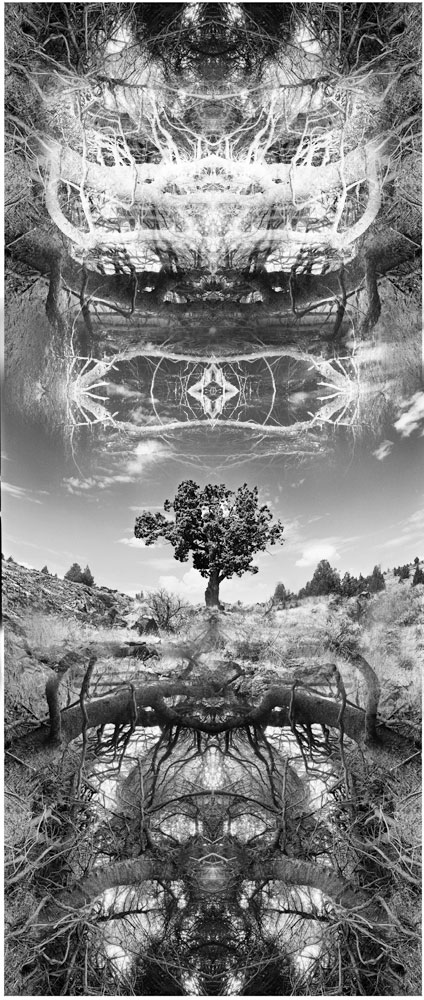
which are also symmetrical

Then I add some more root/branch imagery around the upper edges
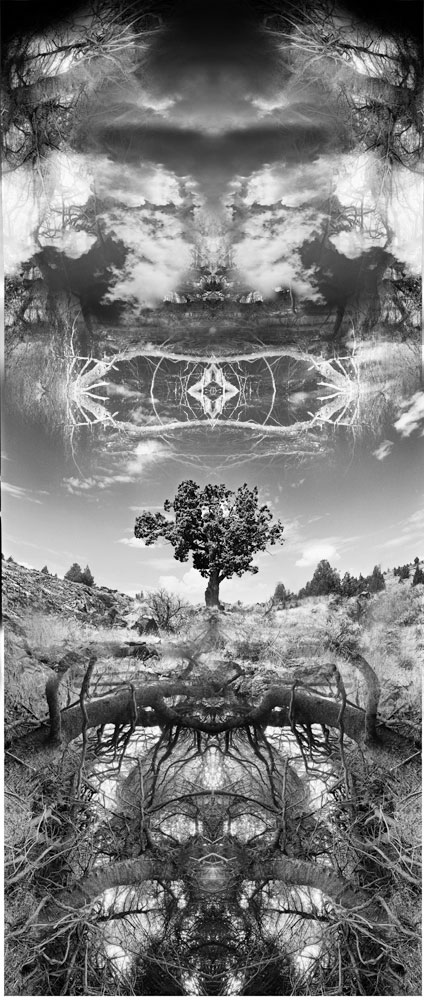
Then I add the face
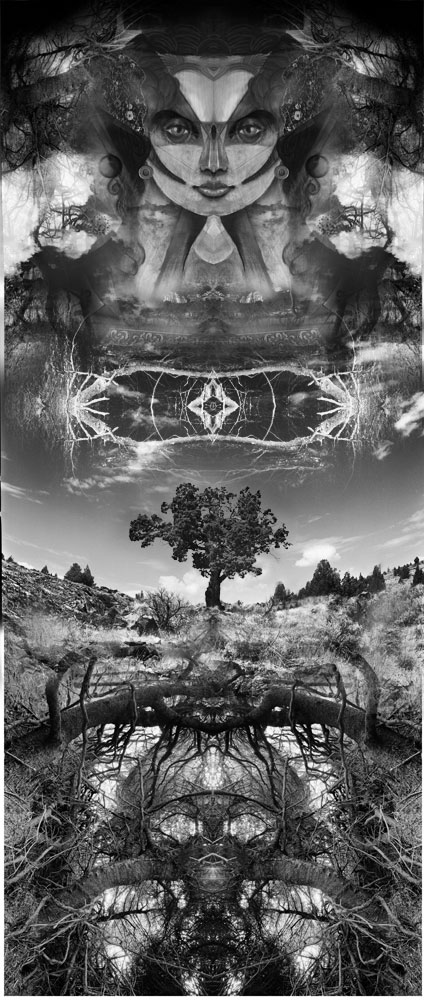
Which came from this scan of mixed media assemblage taken at about the half way point

I converted back to RGB and made some tint and tonal adjustments and I get the finished piece

What strikes me about this process as I go through it now, is how banal and uninteresting the source imagery looks as it comes off the scanner. I think that in most art forms so much depends on the ability of the artist to visualize possibility. To see the potential that sits inherent but invisible in existing material. This usually starts in he field with the camera or perhaps in the art store when looking at a tube of brand new pigment. Then starts a process of exploration and discovery that either does or does not bring success.
For me, Diary of a Root Sprite, has a theme I've touched on numerous times in my work: depictions of hidden realms. The Tree forms the anchor of the composition. Its fairly realistic representation suggests the 'real' world we see day-to-day. When I look at a tree, especially a really large tree, I can't help but think about the idea that its roots form a mirror network of underground growth comparable to the tree itself. (symmetry again) And then that leads me to think about the way the tree connects to the soil, all the microbes and essential minerals, and the water table of the land as a whole. Some ancient cultures would anthropomorphize this life cycle and I too feel compelled to create a personification by adding the image of the female face, framed in more branches, floating in the sky. Could it be an effervescent mirage of the spirit of the tree? or the spirit of the biosphere itself? Perhaps a human face just allows us to feel even more strongly the miraculous nature of life and biology itself, which through its immense complexity and delicacy, creates so much richness in our lives. Of course the face is not really human, but something Ur Human (with cubist tendencies!) perhaps its the face of an archetype in the Jungian sense.
So I suppose Root Sprite could be an image of a tree seen from the perspective of a sensitive human...
Or perhaps it is the view of the our world as seen from the alternate universe of the tree spirit. A reality where the above ground physical space we know forms only a partial manifestation of all the realms, known and unknown, vaguely felt or delicately perceived, that exist around a living organism and its complex habitat.
This is an important theme to me, as it comes up again and again in my work. Its also why I'm starting to do some research on my next film project where I will try to merge this mystical perspective on life sciences with a documentary discussion of organic and sustainable agriculture.
To Post a comment on this page go here